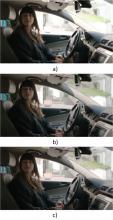BACKGROUND
The contrast in a scene is measured by the ratio, called dynamic range, of light intensity values between its brightest and darkest points. While common natural scenes may have a contrast of 1,000,000:1 or more, our visual system allows us to perceive contrasts of roughly 10,000:1, while the vast majority of displays, including digital cinema projectors, have a limited contrast capability in the order of 1,000:1 and below.
It is not uncommon for camera sensors to have a dynamic range of 3 or 4 orders of magnitude, therefore matching in theory the range of human visual perception, but because of the constrained range of displays the image signals captured by sensors have to be non-linearly transformed so that their contrast is reduced, at the same time trying to maintain the natural appearance and visibility of details of the original. All cameras perform this transformation when they record a photo or video in any standard format; in professional situations cameras are often set to output images as they come out of the sensor, in a format that isn't ready for display but 'raw', so that the non-linear transform can be manually performed by a skilled technician/artist later in post-production. But be it in-camera or off-line, the application of this transform process that compresses the dynamic range is required, if the image is to be displayed. The same situation happens for computer generated images: in videogames as in architectural design or 3D animation, physically realistic models of light-object interactions are used to render an image whose dynamic range has to be reduced for visualization on a regular screen.
The non-linearity applied in most digital cameras is well approximated by a simple power law, and while this type of method is very fast and may perform well on average, in general it is suboptimal because it is not tailored to the specificity of each image. Existing apps for smartphones do increase the visible contrast, but at the expense of introducing noticeable artifacts when there is motion in the scene, or needing a considerable amount of user interaction. In interactive computer graphics there is a compromise between visual quality and execution time, which often leads to rendered images having an appearance that can be improved.
TECHNOLOGY
We have developed a vision model for contrast perception that can be realized as an image- dependent transformation that can accurately reproduce the detail and contrast visible in the original scene. The model is based on findings from psychophysical and neurophysiological studies and is well suited to the statistics of natural images. It has been validated through psychophysical tests that confirm that it outperforms other state of the art algorithms in terms of users’ preference. See example result from ARRI-Alexa professional digital cinema camera in Figure 1, a) conventional non-linear transform of a frame from a video sequence captured by an ARRI-Alexa professional digital cinema camera, b) manual output by a skilled colorist, c) our
automatic result. Notice visibility of details in background. More results on professional photographs and videos in http://ip4ec.upf.edu/tonemapping
ADVANTAGES
The resulting transform is automatic (no need for user-selected parameters) and of extremely low computational complexity, making it a good candidate for real-time applications. It produces
images and videos that look natural, without any halos, spurious colors or artifacts.
STATE OF DEVELOPMENT
Prototype software validated in laboratory environment running on a desktop PC. TRL 4.
INTELLECTUAL PROPERTY
A European patent application has been filed February 6, 2015.
MARKET OPPORTUNITY
Our technology is of interest to companies in the media industries, all along the production chain: camera manufacturers (mobile, still photography, TV, cinema), producers of film, TV or videogames, content distributors (broadcast, internet streaming), and display manufacturers (mobile devices, TV sets, professional monitors). The extremely low complexity of our method allows for real-time software implementation, without any need to modify the hardware. It can also be used off-line, in professional settings, to automatize format conversion processes and produce content with optimal appearance.
COMMERCIAL OPPORTUNITY
Technology available for licensing
CONTACT
Marc Santandreu
Tech Transfer Unit
(+34) 93 542 28 96 [email protected]
KEYWORDS
Image processing, dynamic range, image appearance, visual perception, real-time applications
Ref: TEC-0114/P-0029
Fact Sheet

